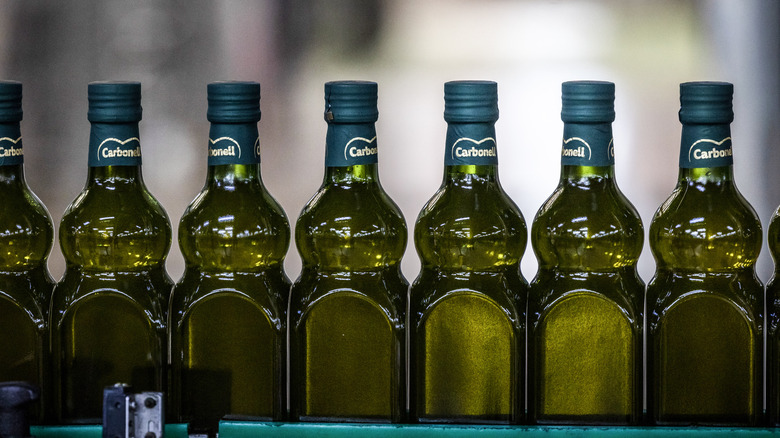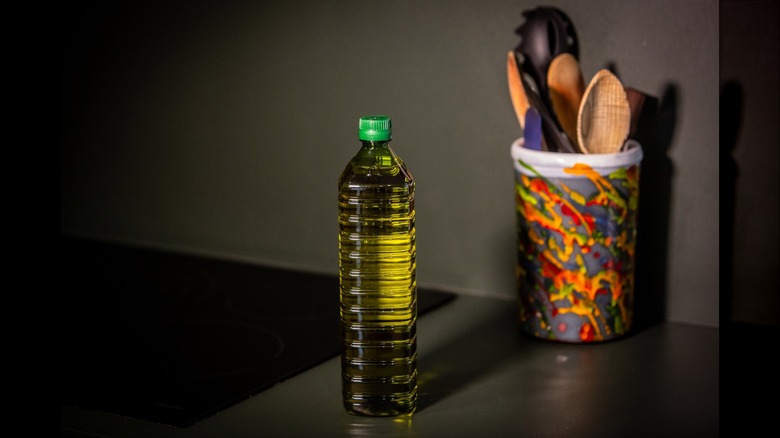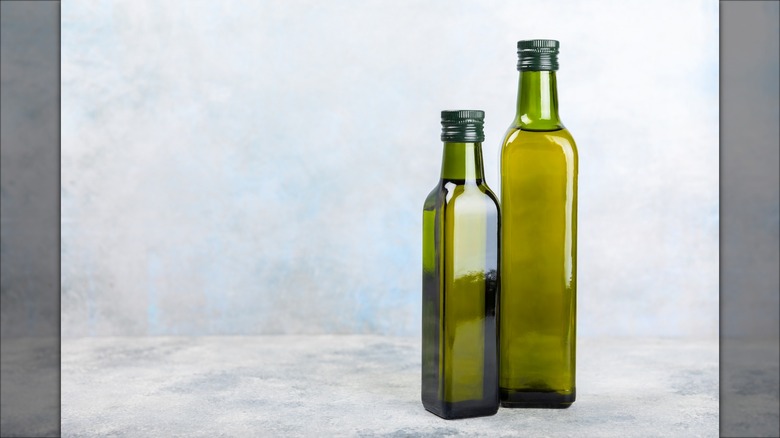Why Olive Oil Bottles Are Often Green
If you've got a bottle of olive oil in your kitchen right now, there's a good chance that bottle is a deep, dark green color. Not always — it's possible to find olive oil in clear bottles and metal containers (among other receptacles) — but dark green seems to be particularly common. That's because the olive oil needs to be protected from external light in order to stay fresh — specifically, it needs to be protected from a chemical process called chlorophyll oxidation.
Olive oil contains a few chemical compounds that can react to things like air and light, and chlorophyll (also known as the substance that makes plants green) is one of those (and you won't find it in other oils). When the chlorophyll in olive oil is exposed to light, it can break down, which negatively impacts the taste and scent of the oil, and can cause it to lose its characteristic bright, fruity flavor, and make it rancid. Green is a preferred color for these bottles because it's considered relatively effective at blocking UV rays from getting through to the oil and causing that oxidation, for a variety of complex reasons related to the wavelengths of light — so, you probably haven't seen a blue olive oil bottle, since it would be less effective at blocking UV light and therefore, wouldn't protect your oil so well.
Just how much does a green bottle protect olive oil?
Green bottles can help extend the shelf life of olive oil, but they won't make your oil invincible. A 2021 study published in Food Chemistry looked at the use of green bottles for extra-virgin olive oil and found that if it was stored for 150 days in a supermarket-like setting, the olive oil would be oxidized (and therefore, degraded). For this study, the oil spent about 12 hours a day in a light setting, and 12 hours in the dark. The same researchers also found that olive oil didn't oxidize when it had been stored in near-constant darkness. So, that means that it's still best to keep your olive oil away from light (especially sunlight) to protect it from oxidation, no matter what type of container it comes in. Keeping it away from heat would also be a wise idea.
It's hard to say for sure, but green may also be preferred by some producers because some shoppers mistakenly believe that the greenness of an olive oil is a marker of its quality (that is, the more green, the better). So, while green bottles also offer protection, they may also play into that misconception. Some researchers have actually suggested that a more olive- or brown-colored bottle may be slightly better at protecting olive oil from UV rays, but it's still best to keep it in a dark place.
What about other types of bottles?
Of course, not all olive oil comes in those green-tinted bottles. If you're shopping for olive oil, you should probably avoid clear bottles: Although it's possible to get clear plastic bottles with UV protection, as a general rule, clear bottles will offer much less protection against oxidized olive oil. This is more important for extra-virgin olive oil (EVOO). If you're buying regular olive oil (without descriptors like "extra virgin"), the oil has been refined and tends to not have the compounds that make EVOO so flavorful, but without these, it's also less likely to oxidize quickly, so the storage container is not quite so important.
A better storage idea would be an opaque container. This could be stainless steel or tin (think about the bulk olive oil containers you might see in a Mediterranean supermarket): These block all light and are considered just as good, if not better, at protecting your oil. Just be sure to avoid metals that react or rust, like copper or iron. Ceramic containers can also do a good job of protecting olive oil from light.


